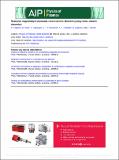Files in this item
Resistive magnetohydrodynamic reconnection : resolving long-term, chaotic dynamics
Item metadata
| dc.contributor.author | Keppens, R. | |
| dc.contributor.author | Porth, O. | |
| dc.contributor.author | Galsgaard, K. | |
| dc.contributor.author | Frederiksen, J.T. | |
| dc.contributor.author | Restante, A.L. | |
| dc.contributor.author | Lapenta, G. | |
| dc.contributor.author | Parnell, C. | |
| dc.date.accessioned | 2014-08-25T16:01:34Z | |
| dc.date.available | 2014-08-25T16:01:34Z | |
| dc.date.issued | 2013-09-13 | |
| dc.identifier | 143241697 | |
| dc.identifier | ce255d88-22a0-4f07-a2d5-579f5ad8ae2f | |
| dc.identifier | 84885027542 | |
| dc.identifier.citation | Keppens , R , Porth , O , Galsgaard , K , Frederiksen , J T , Restante , A L , Lapenta , G & Parnell , C 2013 , ' Resistive magnetohydrodynamic reconnection : resolving long-term, chaotic dynamics ' , Physics of Plasmas , vol. 20 , no. 9 , 092109 . https://doi.org/10.1063/1.4820946 | en |
| dc.identifier.issn | 1070-664X | |
| dc.identifier.other | ORCID: /0000-0002-5694-9069/work/73700718 | |
| dc.identifier.uri | https://hdl.handle.net/10023/5233 | |
| dc.description | We acknowledge financial support from the EC FP7/2007-2013 Grant Agreement SWIFF (No. 263340) and from project GOA/2009/009 (KU Leuven). This research has been funded by the Interuniversity Attraction Poles Programme initiated by the Belgian Science Policy Office (IAP P7/08 CHARM). Part of the simulations used the infrastructure of the VSC-Flemish Supercomputer Center, funded by the Hercules Foundation and the Flemish Government-Department EWI. Another part of the simulations was done at the former Danish Center for Scientific Computing at Copenhagen University which is now part of DeIC Danish e-Infrastructure Cooperation. | en |
| dc.description.abstract | In this paper, we address the long-term evolution of an idealised double current system entering reconnection regimes where chaotic behavior plays a prominent role. Our aim is to quantify the energetics in high magnetic Reynolds number evolutions, enriched by secondary tearing events, multiple magnetic island coalescence, and compressive versus resistive heating scenarios. Our study will pay particular attention to the required numerical resolutions achievable by modern (grid-adaptive) computations, and comment on the challenge associated with resolving chaotic island formation and interaction. We will use shock-capturing, conservative, grid-adaptive simulations for investigating trends dominated by both physical (resistivity) and numerical (resolution) parameters, and confront them with (visco-)resistive magnetohydrodynamic simulations performed with very different, but equally widely used discretization schemes. This will allow us to comment on the obtained evolutions in a manner irrespective of the adopted discretization strategy. Our findings demonstrate that all schemes used (finite volume based shock-capturing, high order finite differences, and particle in cell-like methods) qualitatively agree on the various evolutionary stages, and that resistivity values of order 0.001 already can lead to chaotic island appearance. However, none of the methods exploited demonstrates convergence in the strong sense in these chaotic regimes. At the same time, nonperturbed tests for showing convergence over long time scales in ideal to resistive regimes are provided as well, where all methods are shown to agree. Both the advantages and disadvantages of specific discretizations as applied to this challenging problem are discussed. | |
| dc.format.extent | 17 | |
| dc.format.extent | 31193968 | |
| dc.language.iso | eng | |
| dc.relation.ispartof | Physics of Plasmas | en |
| dc.rights | © 2013 AIP Publishing LLC | en |
| dc.subject | QC Physics | en |
| dc.subject.lcc | QC | en |
| dc.title | Resistive magnetohydrodynamic reconnection : resolving long-term, chaotic dynamics | en |
| dc.type | Journal article | en |
| dc.contributor.sponsor | European Commission | en |
| dc.contributor.institution | University of St Andrews.School of Mathematics and Statistics | en |
| dc.contributor.institution | University of St Andrews.Applied Mathematics | en |
| dc.identifier.doi | 10.1063/1.4820946 | |
| dc.description.status | Peer reviewed | en |
| dc.identifier.url | http://www.scopus.com/inward/record.url?eid=2-s2.0-84885027542&partnerID=8YFLogxK | en |
| dc.identifier.grantnumber | 263340 | en |
This item appears in the following Collection(s)
Items in the St Andrews Research Repository are protected by copyright, with all rights reserved, unless otherwise indicated.

